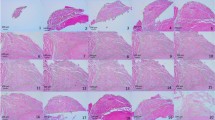Abstract
The presence of left ventricular bands has drawn attention to their possible clinical importance, though there are no concrete data to support their role in serious clinical diseases. We have investigated the incidence, location, microscopic and macroscopic structure of left ventricular bands in the human and animals. We examined 100 hearts: 28 human and 72 animal (dog, goat, sheep). Left ventricular bands were present in 13 of 28 (46%) human hearts and 62 of 72 (86%) animal hearts. The bands usually extended from the interventricular septum to the free walls in human hearts and from the papillary muscles to the interventricular septum in animal hearts. They were composed of muscle tissue in various proportions in human and dog hearts, and of connective and conductive tissue in sheep and goat hearts.








Similar content being viewed by others
References
Abdulla AK, Frustaci A, Martinez JE, Florio RA, Somerville J, Olsen EGJ (1990) Echocardiography and pathology of left ventricular “false tendons.” Chest: 98: 129–132
Calabro MP, De Luca F, Consolo S, Falcone G, Oreto G (1992) Left ventricular false tendon: the most frequent cause of “innocent” murmur in childhood? G Ital Cardiol 22: 19–24
Casta A, Wolf WJ (1986) Left ventricular bands (false tendons): echocardiographic and angiocardiographic delineation in children. Am Heart J 111: 321–324
Cocchieri M, Bardelli G (1992) False chordae tendineae. Minerva Cardioangiol 40: 353–358
Gerlis LM, Wright HM, Wilson N, Erzengin F, Dickinson DF (1984) Left ventricular bands: a normal anatomical feature. Br Heart J 52: 641–647
Glover MU, Bloor C, Vieweg WVR (1986) Anomalous left ventricular band diagnosed by two-dimensional echocardiography. Am Heart J 111: 805–806
Grzybiak M, Lotkowski D, Kozlowski D (1996) False tendons in the left ventricle of the heart in humans during pre-and postnatal periods. Folia Morphol (Warsz) 55: 89–99
Gueron M, Cohen W (1972) Anomalous left ventricular chordae tendineae and pre-excitation: unusual cause of praecordial pansystolic murmur in a baby with fibroelastosis. Br Heart J 34: 966–968
Lotkowski D, Grzybiak M, Kozlowski D, Budzyn K, Kuta W (1997) A microscopic view of false tendons in the left ventricle of the human heart. Folia Morphol (Warsz) 56: 31–39
Luetmer PH, Edwards WD, Seward JB, Tajik AJ (1986) Incidence and distribution of left ventricular false tendons: an autopsy study of 483 normal human hearts. J Am Coll Cardiol 8: 179–183
Malouf J, Gharzuddine W, Kutayli F (1986) A reappraisal of the prevalence and clinical importance of left ventricular false tendons in children and adults. Br Heart J 55: 587–591
Okamoto M, Nagata S, Park YD, Masuda Y, Beppu S, Yutani C, Sakakibara H, Nimura Y (1981) Visualization of the false tendon in the left ventricle with echocardiography and its clinical significance. J Cardiogr 11: 265–270
Pierard LA, Henrard L, Noel J-F (1985) Detection of left ventricular false tendons by two-dimensional echocardiography. Acta Cardiol 40: 229–235
Roberts WC (1969) Anomalous left ventricular band: an unemphasized cause of a precordial musical murmur. Am J Cardiol 23: 735–738
Salazar J (1997) Left ventricular anomalous muscle band and electrocardiographic repolarisation changes. Pediatr Cardiol 18: 434–436
Suwa M, Hirota Y, Kaku K, Yoneda Y, Nakayama A, Kawamura K, Dio K (1988) Prevalence of the coexistence of left ventricular false tendons and premature ventricular complexes in apparently healthy subjects: a prospective study in the general population. J Am Coll Cardiol 12: 910–914
Suwa M, Hirato Y, Nagao H, Kino M, Kawamura K (1984) Incidence of the coexistence of left ventricular false tendons and premature ventricular contractions in apparently healthy subjects. Circulation 70: 793–798
Thakur RK, Klein GJ, Sivaram CA, Zardini M, Schleinkofer DE, Nakagawa H, Yee R, Jackman WM (1996) Anatomic substrate for idiopathic left ventricular tachycardia. Circulation 93: 497–501
Author information
Authors and Affiliations
Corresponding author
Rights and permissions
About this article
Cite this article
Deniz, M., Kilinç, M. & Hatipoglu, E.S. Morphologic study of left ventricular bands. Surg Radiol Anat 26, 230–234 (2004). https://doi.org/10.1007/s00276-003-0212-0
Received:
Accepted:
Published:
Issue Date:
DOI: https://doi.org/10.1007/s00276-003-0212-0




